A friend of mine got married recently and I was lucky enough to be part of the wedding. During the lengthy photo session, my mind began to wander. As I looked around at all of the photographer’s equipment, I found myself wondering, what’s the difference between white and black photography umbrellas?
After the photo session, I pulled the photographer aside, and he was kind enough to explain the difference between the umbrellas. Photography umbrellas are used to control light, but different umbrellas do it in different ways.
So what’s the difference between White and Black Photography Umbrellas? White umbrellas usually diffuse, or spread, light. They’re typically placed between the light source and the subject, softening the light. Black umbrellas are often lined with reflective material and work by directing and magnifying the light onto the subject. Photographers usually point the light at the umbrella rather than the subject, and the light is reflected off the umbrella back onto the subject.
Photography umbrellas come in a variety of different colors, sizes, and shapes. Depending on the subject of the photo, the setting, and the style of shot the photographer wants to capture, he or she may use different umbrellas. There’s a lot more that goes into selecting an umbrella than simply deciding whether you want to diffuse or magnify the light.
Contents [show]
When to Use White Umbrellas and When to Use Black
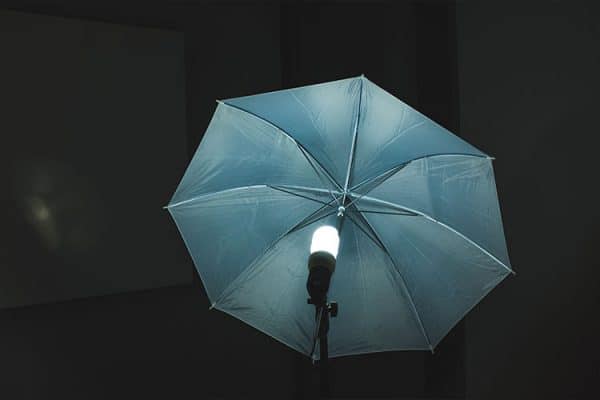
The type of umbrella a photographer uses will depend upon the end result he/she is seeking. A white umbrella diffuses light for a softer effect on the subject. Because white umbrellas diminish light output, they’re considered light-inefficient. Sometimes this is exactly what a photographer is seeking.
White umbrellas are sometimes referred to as shoot-through umbrellas because the photographer places the umbrella between the light and their subject. The light points directly at the subject but passes through the umbrella. This softens the light and casts more gentle shadows on the subject than if the photo was taken without the umbrella.
When photographing just one or two people, a photographer may place the shoot-through umbrella close to their subject. If the subject is a large group of people, the photographer may choose to move the umbrella further from the group to spread the light across a greater area. However, since a shoot-through white umbrella reduces the intensity of the light, the photographer may need to either increase the intensity of the light source, use a larger light, or use multiple sources of light to properly illuminate the group.
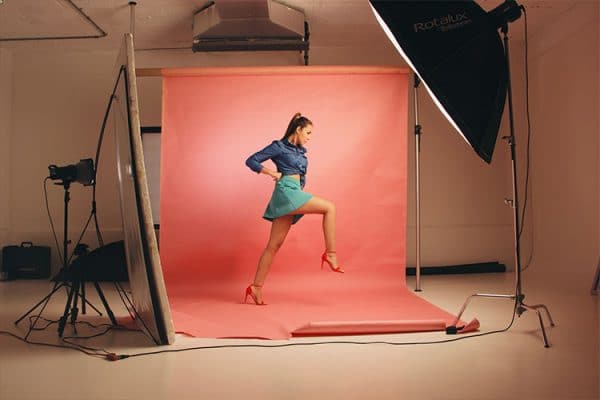
Black umbrellas function and are used differently than white shoot-through umbrellas. Shoot-throughs are placed between the subject and the light with the light pointing toward the subject. With a black umbrella, the light is placed between the subject and the umbrella. The light points directly at the umbrella rather than at the subject. In this setup, the light reflects off the umbrella and then back at the subject. Pointing the light at a reflective surface serves to magnify and intensify the light, as well as give it more obvious direction than when using a shoot-through.
Because black umbrellas have a reflective interior, a photographer can move the light source further from their subject without losing intensity, so a black umbrella is considered a more efficient light source than a white one. The end result is that the light can spread over a larger area, but remain bright and focused.
Black umbrellas are typically lined with either white or silver reflective material, and may even be lined with gold. The effect created by a black umbrella is highly dependent upon the color of its interior. There are also black umbrellas with no lining which have a very different purpose. We’ll talk more about these true black umbrellas in a different section.
A white umbrella with a black exterior is the most neutral of the three reflective options. A reflective white umbrella is different than a shoot-through white because it intensifies the light rather than diminishing it. It can produce more contrast between highlights and shadows than a shoot-through white but is also more neutral in tone and less dramatic than a silver or gold umbrella. It keeps the colors in the photo more true to real life.
Silver-lined umbrellas are popular among photographers because they intensely magnify the light source and create dramatic, edgy photos. Silver umbrellas help you achieve greater contrast between highlights and shadows because the shadows are more harsh and defined. The silver also creates a cooler toned image than either white or gold umbrellas.
Gold-lined umbrellas also magnify the source of light to create dramatic photos, but they create more warm-toned images than the other two colors. This can have wonderful effects on skin tone. However, it can distort other colors like white wedding dresses, so gold umbrellas may not be suitable for some situations.
The intensity of the light and the desired temperature of the photo are all important determiners in selecting the proper umbrella for a shoot. You can create major differences in photos by making simple changes like choosing a shoot-through umbrella rather than a reflective umbrella, or by using a silver umbrella rather than white.
Different Umbrella Sizes and When to Use Them

Umbrellas come in many different sizes, from about 20 inches in diameter to over 7 feet. Larger sources of light appear softer on a subject than smaller sources of light. Think of how different someone would look photographed with a flashlight shining on their face versus with a table lamp beside them.
For dramatic shadows and highlights, a photographer may choose to use smaller umbrellas. For softer, diffused shadows, a photographer may choose a larger umbrella.
The strength of the light is affected by how close the umbrella is to the subject, as well as how close the light is to the umbrella. A bright light placed close to a small, reflective umbrella will create dramatic shadows, especially if the setup is placed near the subject. A large umbrella, even a reflective one, will create much softer shadows when placed a number of feet from a subject.
Something to consider when using a large umbrella, especially a white shoot-through, is that you may need a stronger light source to maintain your desired brightness.
Large umbrellas can be very useful for outdoor shoots. The sun is an incredibly large source of light, so you’ll need a large umbrella if you want to diffuse it. Another use for large umbrellas is with large groups of people. To properly light a group, you need a larger source of light, which large umbrellas can provide. Another alternative is to use multiple smaller reflective umbrellas.
By varying both the size of the umbrella and the variety (shoot-through, reflective silver, etc.), a photographer can dramatically alter the lighting on their subject. Even outdoor light can be manipulated drastically with the right tools.
Different Umbrella Shapes and When to Use Them
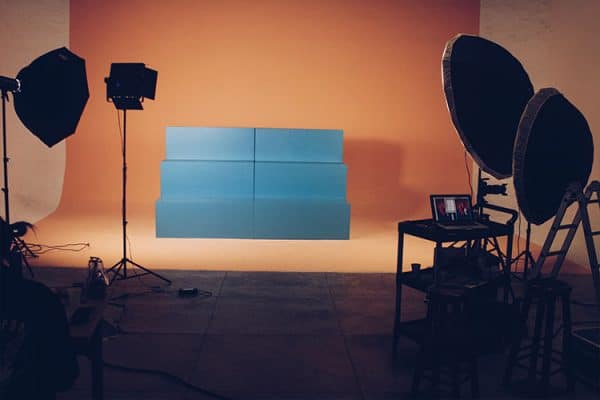
Photography umbrellas come in two common shapes, regular and parabolic. Regular photography umbrellas are shaped exactly like the type you’d used on a rainy day.
Typically, regular photography umbrellas have eight triangular panels. The panels on a regular umbrella are larger than those on a parabolic and the umbrella is more open and wide, so they diffuse light more gently.
Parabolic umbrellas have many more panels than regular umbrellas and are often larger in size. They’re usually more tightly rounded than regular umbrellas. Since parabolic umbrellas have more panels and are more tightly rounded, you can create a more focused light source with them than with a regular umbrella.
Think about the difference between a bare bulb and one in a lampshade. The bare bulb, like a regular umbrella, shines light all over the room, while the lampshade directs the light down onto the table. A parabolic umbrella affects light much like a lampshade, pointing the light more directly toward where the photographer desires.
Something to keep in mind with parabolic umbrellas, or any large regular umbrella, when shooting outdoors is that you need to carefully secure them before shooting. Large umbrellas are shaped in such a way that they can very easily catch wind and tip over, causing injury.
True Black Umbrellas and When to Use Them
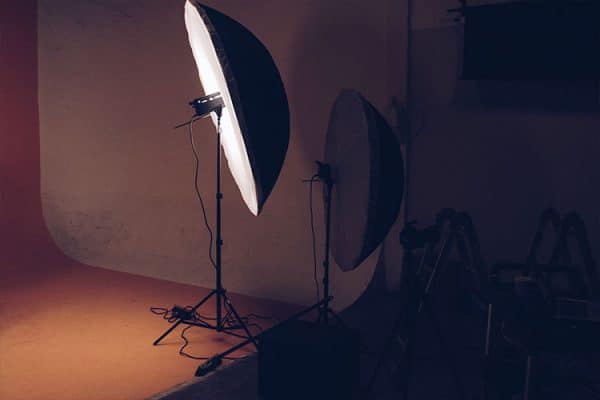
Some umbrellas are purely black on the inside and out. This type of umbrella has the opposite effect of the other umbrellas. Rather than diffusing light or magnifying it, the purpose of a fully black umbrella is to absorb light.
This can be useful when doing outdoor shoots if the sun is shining too brightly. A photographer can create shadows by placing a large shoot-through umbrella in one area to diffuse the sunlight, while also placing a true black umbrella opposite it. This will soften the light on one side of the subject, while absorbing light on the other side, thus creating contrast lighting that’s less harsh than plain sunlight.
True black umbrellas, or even black panels, are often used in indoor photography studios also. Umbrellas reflect a lot of light, so dark umbrellas absorb excess light spilling into the photo’s focal area. This helps intensify the shadows on a subject’s face. Dampening some of the light can actually make colors appear more brilliant and less washed out.
Photography Umbrellas vs. Softboxes
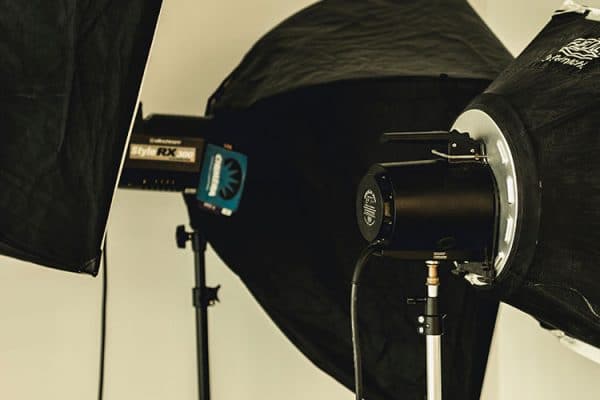
Umbrellas are a very common tool used to alter lighting in photos, but they’re certainly not the only one. Softboxes are another popular type of light diffuser among photographers. The main difference between the two is that umbrellas cause light to spread wide, and softboxes keep light focused in a specific direction.
One of the advantages of using umbrellas is that they’re affordable. You can purchase a variety of different umbrellas, thus giving yourself a multitude of ways to manipulate light, for a very reasonable price. Another advantage is that they’re highly portable. They simply fold up like any rain umbrella and they’re lightweight.
Beginners are more likely to be successful with an umbrella than a softbox. Shoot-through umbrellas are so simple that anyone can make one work. They don’t rely heavily on perfect distance placement and angles like reflective umbrellas or softboxes. They’re ideal for rookies because they’re so effective at diffusing light that they can mask a lot of lighting mistakes.
Softboxes are a bit more complicated to set up than an umbrella, but not by much. Typically, however, they are more expensive than an umbrella, especially as they increase in size. Since softboxes focus light much more directionally than an umbrella, proper lighting of a subject requires the softbox to be about the size of the subject. For a full-body portrait, you’d need quite a large softbox.
Softboxes can be more challenging to correctly place for proper lighting than umbrellas, especially for beginners. However, once you get the hang of it you can create beautiful light and shadows with a softbox.
Related Questions

What is a diffuser in photography?
A diffuser is any tool you can use to soften and spread light for a photo. Umbrellas are common diffusers, as are softboxes. You can even get rectangular plastic diffusers that attach to an on-camera flash to soften its light.
Is a softbox better than an umbrella?
Both softboxes and umbrellas are used to diffuse light, but they do so in different ways. Softboxes are more directional and umbrellas create a more wide, gradient light effect. Neither is objectively better or worse, they’re just very different. Which diffuser is better is completely dependent upon your setting and the type of shot you want to capture.
What does a speedlight do?
A speedlight is a battery powered flash that can be used on or off a camera. You can use it off-camera as a light source for use with an umbrella, both shoot-through and black umbrellas with reflective interiors.
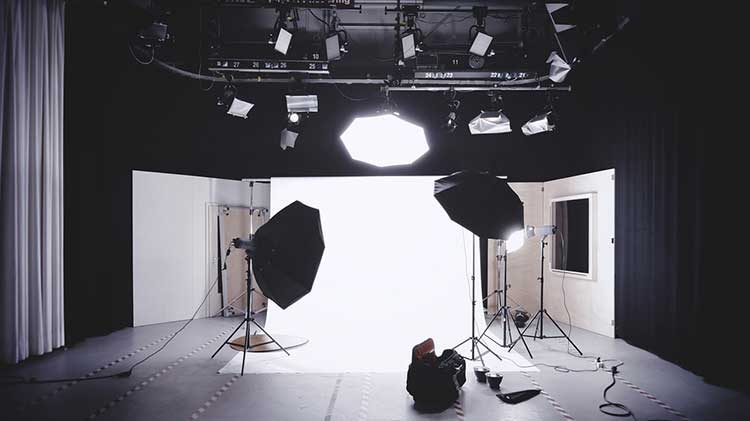
Soooo helpful! Thank you